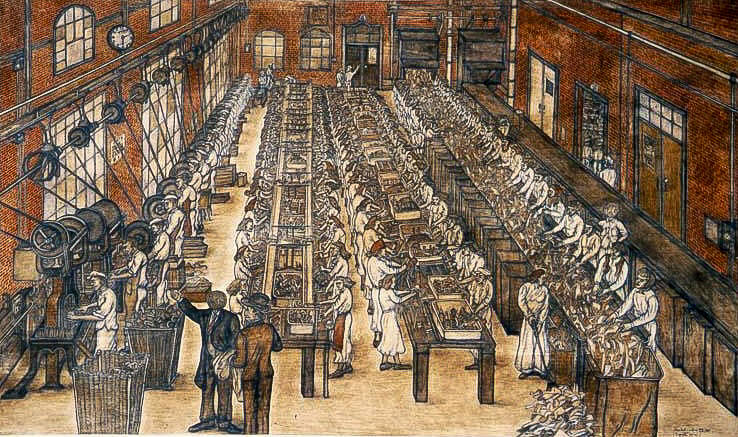The Communiqué on the January 2025 Statistics Regarding the Number of Workers in Sectors and the Membership Numbers of Unions, issued by the Ministry of Labor and Social Security, has been published in the Official Gazette.
According to the report, out of 16,864,733 workers, 2,524,547—equivalent to 14.97%—are members of a labor union.
Among the 20 labor sectors, the one with the highest number of workers is "trade, office, education, and fine arts," with 4,469,945 workers. This is followed by the "metal" sector with 1,987,733 workers and the "construction" sector with 1,741,475 workers.
Türk-Metal Union, with 293,829 members, ranks first among all labor unions. It is followed by Hizmet-İş with 280,769 members and Öz Sağlık-İş with 224,289 members.
bianet.org examined how these figures reflect changes in Turkey's class composition over the past 50 years. The general trend indicates that while wage workers have become the largest segment of the population, unionization rates in the 2020s have dropped to half of what they were in the 1970s.
Share of working class in population
1970s:
Estimated population: 35–40 million.
Total number of workers: Approximately 5–6 million.
Workers as a percentage of the population: Around 12–15%.
In the 1970s, the agricultural sector still held a significant share, and the rate of informal employment was high.
1980s:
Estimated population: 45–50 million.
Total number of workers: Approximately 7–8 million.
Workers as a percentage of the population: Around 14–16%.
Industrialization gained momentum in the 1980s, but agriculture remained an important source of employment.
1990s:
Estimated population: 55–60 million.
Total number of workers: Approximately 10–12 million.
Workers as a percentage of the population: Around 16–20%.
During the 1990s, the service sector began to expand, and urbanization increased.
2000s:
Estimated population: 65–70 million.
Total number of workers: Approximately 13–15 million.
Workers as a percentage of the population: Around 18–22%.
By the 2000s, the service and industrial sectors accounted for the majority of employment, while the share of agriculture continued to decline.
2010s:
Estimated population: 75–80 million.
Total number of workers: Approximately 18–20 million.
Workers as a percentage of the population: Around 22–25%.
In the 2010s, the service sector made up the largest portion of employment. The rate of informal employment remained high.
2020s:
Estimated population: 85 million (as of 2023).
Total number of workers: Approximately 22–24 million.
Workers as a percentage of the population: Around 25–28%.
In the 2020s, the service and industrial sectors continued to dominate employment, while the share of the agricultural sector declined further.
Overall trend
The proportion of workers within Türkiye’s population has steadily increased from the 1970s to the 2020s. The key factors driving this increase include:
- Urbanization and industrialization,
- A declining share of the agricultural sector,
- A partial increase in women's participation in the workforce,
- Increased workforce participation among younger populations.
However, the high rate of informal employment continues to impact official statistics.
Unionization
1970s:
Total number of workers: Approximately 5–6 million (registered workers in the industrial and service sectors).
Unionized workers: Approximately 1.5–2 million.
Unionization rate: Around 25–30%.
The 1970s was a period when unionization was relatively strong. The Confederation of Progressive Trade Unions of Türkiye (DİSK) was influential in the private sector, while Türk-İş played a dominant role in the public sector.
1980s:
Total number of workers: Approximately 7–8 million.
Unionized workers: Approximately 1.5–2 million.
Unionization rate: Around 20–25%.
Following the September 12, 1980, military coup, the labor movement weakened significantly. DİSK was shut down, and union activities were severely restricted.
1990s:
Total number of workers: Approximately 10–12 million.
Unionized workers: Approximately 2–2.5 million.
Unionization rate: Around 20%.
Unionization remained at low levels throughout the 1990s. The informal economy expanded, and flexible working models became more widespread.
2000s:
Total number of workers: Approximately 13–15 million.
Unionized workers: Approximately 2.5–3 million.
Unionization rate: Around 15–20%.
The decline in unionization continued throughout the 2000s. Union membership in the service sector, in particular, remained weak.
2010s:
Total number of workers: Approximately 18–20 million.
Unionized workers: Approximately 3–3.5 million.
Unionization rate: Around 15–18%.
In the 2010s, unionization remained low. The public sector had relatively higher unionization rates compared to the private sector.
2020s:
Total number of workers: Approximately 22–24 million.
Unionized workers: Approximately 4–4.5 million.
Unionization rate: Around 15–20%.
In the 2020s, unionization rates remain low. Particularly in the private sector and among informal workers, union membership is extremely low.
Overall trend
Unionization rates in Türkiye have generally declined since the 1970s. The main reasons for this include:
- The widespread prevalence of the informal economy,
- The increase in flexible working models,
- Legal and political restrictions on labor movements,
- Weak union presence in the private sector. (AEK/VK)





